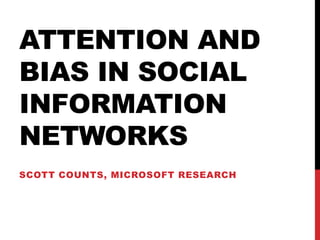Attention and Bias in Social Information Networks
- 1. Attention and bias in social information networksScott counts, microsoft research
- 4. Looking time per tweet is short, memory is poor.
- 5. Looking time per tweet is short, memory is poor.
- 6. Looking time per tweet is short, memory is poor.
- 7. Including links, RTs, heavy tweeting all decrease attention and/or interest.
- 8. Including links, RTs, heavy tweeting all decrease attention and/or interest.
- 9. Including links, RTs, heavy tweeting all decrease attention and/or interest.
- 10. Including links, RTs, heavy tweeting all decrease attention and/or interest.
- 11. Personal contacts increase attention and memory.Counts, S., & Fisher, K. (2011). Taking It All In? Visual Attention in Microblog Consumption. In Proc. ICWSM ˇ®11.
- 13. Problem statementHow does a userˇŻs name influence perception of her and her content?
- 16. Results ¨C author ratingsFairly bimodal distributionsDownward shift in ratings when non-anonymous
- 17. Results ¨C rating distributionGood author get higher ratings when non-anon.Bad authors hurt most by namesAverage authors similar to good (KL div = .02) but hurt by name (KL div = .23; p < .001)
- 18. Results ¨C ratings & follower countResults tighten up with names: R2 = .16 -> .21High follower count people get biggest boostMiddle group hurtPal, A., & Counts, S. (2011). WhatˇŻs In a @Name? How Name Value Biases Judgment of Microblog Authors. In Proc. ICWSM ˇ®11.
- 24. Credibility and truth*Name type impacts tweet and author credibilityCorrelations between truth and tweet (r = .39) and author (r = .29) modest* Morris, M., Counts, S., Roseway, A., Hoff, A., & Schwartz, J. (2011). Under review.
- 26. Bringing it togetherMinimal visual processing/attentionPoor memory encoding
- 27. Bringing it togetherMinimal visual processing/attentionPoor memory encodingDifficulty in determining truthfulnessSystematic use of heuristics (biases)FriendsName value
- 28. Bringing it togetherMinimal visual processing/attentionPoor memory encodingDifficulty in determining truthfulnessSystematic use of heuristics (biases)FriendsName value** Peripheral processing route **
- 29. Implications
- 30. ImplicationsEffective reach of social media
- 31. ImplicationsEffective reach of social media Information diffusion
- 32. ImplicationsEffective reach of social media Information diffusion Social contagion: Stickiness* (increased adoption and sustained product use) and memory for content* Aral, S., & Walker, D. (2010). Creating Social Contagion Through Viral Product Design: A Randomized Trial of Peer Influence Networks. Management Science.
- 33. Attention and bias in social information networksScott counts, microsoft research
- 34. low level :: your brain on facebook** Fisher, K., & Counts, S. (2010). Your Brain on Facebook: Neuropsychological Associations with Social Versus Other Media. In Proc. ICWSM ˇ®10.
- 35. social information networks :: levels of analysisMath/TheorySocial media analyticsComputer-Mediated CommunicationSocial CognitionPhysiological
- 36. Results ¨C factors for bias: genderMost top authors are gender neutral (e.g., Time, Mashable)Men higher than women when anonymous, but drop more when names shownWomen get slight bump when names shownPal, A., & Counts, S. (2011). WhatˇŻs In a @Name? How Name Value Biases Judgment of Microblog Authors. In Proc. ICWSM ˇ®11.
- 37. social information networks :: levels of analysisMath/TheorySocial media analyticsComputer-Mediated CommunicationSocial CognitionPhysiological
- 38. Problem statementHow does a userˇŻs name influence perception of her and her content?
- 39. Problem statementHow does a userˇŻs name influence perception of her and her content?
Editor's Notes
- alshepmcr







































